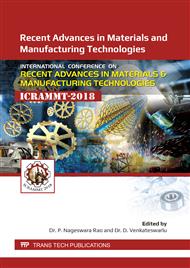p.775
p.781
p.787
p.794
p.800
p.807
p.813
p.819
p.828
Application of Machine Learning Techniques for Multi Objective Optimization of Response Variables in Wire Cut Electro Discharge Machining Operation
Abstract:
Wire Cut Electrical Discharge Machining (WEDM) is a non-conventional thermal machining process which is capable of accurately machine alloys having high hardness or part having complex shapes that are very difficult to be machined by the conventional machining processes. The WEDM finds applications in automobiles, aero–space, medical instruments, tool and die industries, etc. The input parameters considered for WEDM are pulse on time, pulse off time, flushing pressure, servo voltage, wire feed rate and wire tension. Performance of WEDM is mainly assessed by output variables such as, material removal rate (MRR), kerf width (Kw) and surface roughness (Ra) of the work piece being machined. Looking at the need of a suitable optimization model, the present work explores the feasibility of machine learning concepts to predict optimum surface roughness and kerf width simultaneously by making use of experimental data available in the literature for machining of Hastelloy C– 276 using WEDM. In most of the literatures, single objective optimization has been carried out for predicting optimum cutting parameters for WEDM. Hence, the present work presents a methodology that makes use of a machine learning algorithm namely, gradient descent method as an optimization technique to optimize both surface roughness and kerf width simultaneously (multi objective optimization) and compare the results with the existing literatures. It was observed that the input parameters such as pulse on time, pulse off time, and peak current have significant effect on both surface roughness and kerf width. The gradient descent method was successfully used for predicting the optimum values of response variables.
Info:
Periodical:
Pages:
800-806
Citation:
Online since:
August 2019
Authors:
Keywords:
Price:
Сopyright:
© 2019 Trans Tech Publications Ltd. All Rights Reserved
Share:
Citation:


